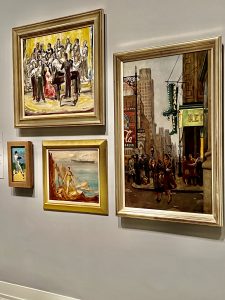
1940’s painting by Upper West Sider Henry E. Schnakenberg
Columbus Circle has been a moving target for decades with its character and the geography of its traffic routes changing over time. In the early 1940s, artist Henry E. Schnakenberg (1892-1970) who then lived on West End Avenue, captured the vitality of the southeast corner of West 58th Street. The painting, now part of an exhibit entitled Scenes of New York City at the New-York Historical Society, depicts a view looking uptown across the iconic Coca Cola Sign, a bit of the glowing orange Mayflower Hotel rooftop sign and a vista of familiar CPW buildings looking north.
In the foreground, two women in high heels, swathed in furs are waiting, arm in arm, for the red light to change to green (only 2-colored lights) a mailman is picking up mail from a box attached to a post. Another glimpse backward in time, three men are wearing overcoats with the dark fedoras that were typical for the times. One is walking with a newspaper in hand, another is browsing the pages of his paper. The crush of activities crowd out the Columbus Circle monument which is nonetheless central in what looks to be a breezy fall scene.
To the right in the canvas, Regal Shoes is clearly announced by two large signs in the shape of boots. They are exuberantly illuminated with small light bulbs. Ironically, this store which had occupied the 1789 Broadway/2 Columbus Circle site for decades was soon to be evicted.
This was just one of many Regal stores established in NYC and across the country. Regal’s reputation extended far beyond. “In 1895 the company claimed that Czar Nicholas II, Napoleon Bonaparte, the Mikado of Japan, and the Emperor of China all wore Regal shoes.” The Boston-based business was opened by Elmer Bliss in 1894.
Regal shoes were widely and imaginatively advertised in illustrated print ads with clever copy. One advertisement for the Regal Shoe Company shows a shoe superimposed on a bird’s-eye-view map of the city. According to the 1897 advertising text, “The total number of Regal shoes sold in the year 1897 from our New York and Brooklyn stores, if made into one shoe, would be about 34 miles long and 17 miles high. This would cover in square miles a greater area than now covered by Greater New York.” As hemlines rose and fashion styles changed for both men and women, the Regal look became outmoded and the company was absorbed into one shoe company which was then taken over by another.
The death toll for the Regal Shoe store on West 58th Street was the decision in favor of the landlord in the eviction case heard by Judge Maurice Wahl in the Municipal Court of the City of New York on October 30, 1959. The landlord, the A & P heir Huntington Hartford wanted to reconfigure the existing building or construct a new one for the museum he envisioned.
The judge was sympathetic to the landlord and the prospect of a new museum and less impressed by the technicalities of a lease that might be supportive of the tenant’s continued use of the building. He wrote:
“The court takes judicial notice that New York City is one of the world’s great centers of art, music, culture and entertainment. The area where the instant property is located was only recently cleared of slums and the magnificent Coliseum erected. Not far away, the new Lincoln Center development is being constructed, a new opera house, a law school, the philharmonic society and other cultural and artistic endeavors will be housed there.
Landlord’s projected contribution here is and will be welcome to the people of the city and all its visitors. In an ever expanding and kaleidoscopic change, social welfare and progress must take place. In such an evolution certain private rights must be subordinated to the demands and needs of many.”
The former Huntington Hartford Museum underwent major renovations over the years and is now the Museum of Arts and Design.
In past decades, street level shops crowded the Columbus Circle area. Today many walk-in stores, including Whole Foods and the Shops at Columbus Circle are located below ground in the Deutsche Bank Complex. A number of upscale brands are ensconced on the entry level and on higher floors of the mall.
In its current iteration Columbus Circle is a much cleaned up, sleeker, less colorful version of what it was in the 40s, 50s and early 60s. There are far fewer horse drawn tourist carriages at the edge of the park, or fur coats worn anywhere in the area. Men wear baseball caps, rather than felt fedoras and virtually no one carries newspapers. But there is bustle by the base of the USS Maine National Monument (dedicated in 1913) where today, postcards, and photos of NYC are sold from temporary stands and pedi-cab tours of Central Park are widely available.
